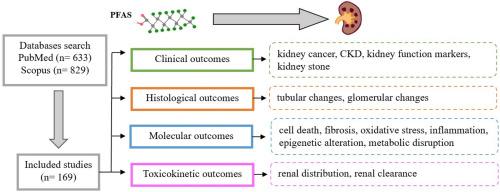接触全氟烷基物质(PFAS)对肾脏的临床、组织学、分子和毒物动力学影响:系统回顾和荟萃分析。
IF 8.1
2区 环境科学与生态学
Q1 ENVIRONMENTAL SCIENCES
引用次数: 0
摘要
背景:全氟烷基和多氟烷基物质(PFAS)是存在于环境中的合成化学物质,可对健康产生负面影响。肾脏是暴露于 PFAS 的主要靶器官,但人们对 PFAS 对肾脏的影响还不完全了解。在此,我们回顾了接触全氟辛烷磺酸对肾脏健康的影响,以找出我们认识上的差距,并指出未来研究的潜在途径:方法:我们在 PubMed 和 SCOPUS 数据库中搜索了有关 PFAS 暴露与肾脏相关结果之间关系的研究。我们纳入了所有流行病学、动物和细胞研究,并将结果分为四类:临床、组织学、分子和毒物动力学:我们确定了 169 项研究,其中 51 项涉及临床结果,28 项涉及组织学变化,42 项涉及分子机制,68 项涉及毒代动力学。全氟辛酸(PFOA)和全氟辛烷磺酸(PFOS)暴露与肾功能障碍、慢性肾病和肾癌风险增加有关。各种组织学变化均有报道,特别是肾小管上皮细胞,而全氟辛烷磺酸诱发肾损伤的病因包括各种分子机制。虽然全氟辛烷磺酸和全氟辛烷磺酸不被认为具有基因毒性,但它们表现出致癌物的若干特征。全氟辛烷磺酸和全氟辛烷磺酸的毒物代谢动力学在不同物种之间存在显著差异,肾脏消除受性别、年龄和化合物结构等各种因素的影响:有证据表明,全氟辛烷磺酸,尤其是全氟辛酸和全氟辛烷磺酸,会对肾脏健康产生负面影响,但我们对这种影响的认识还存在差距,需要进一步研究。本文章由计算机程序翻译,如有差异,请以英文原文为准。

Clinical, histological, molecular, and toxicokinetic renal outcomes of per-/polyfluoroalkyl substances (PFAS) exposure: Systematic review and meta-analysis
Background
Per- and polyfluoroalkyl substances (PFAS) are synthetic chemicals present in the environment that can negatively affect health. Kidney is the major target organ of PFAS exposure, yet the renal impact of PFAS is not completely understood. Here we review the effects of PFAS exposure on kidney health to identify gaps in our understanding and mark potential avenues for future research.
Methods
PubMed and SCOPUS databases were searched for studies that examined the association between PFAS exposure and kidney-related outcomes. We included all epidemiological, animal, and cell studies and categorized outcomes into four categories: clinical, histological, molecular and toxicokinetic.
Results
We identified 169 studies, including 51 on clinical outcomes, 28 on histological changes, 42 on molecular mechanisms, and 68 on toxicokinetics. Perfluorooctanoic acid (PFOA) and perfluorooctane sulfonic acid (PFOS) exposure were associated with kidney dysfunction, chronic kidney diseases, and increased risk of kidney cancer. Various histological changes were reported, especially in tubular epithelial cells, and the etiology of PFAS-induced kidney injury included various molecular mechanisms. Although PFOA and PFOS are not considered genotoxic, they exhibit several characteristics of carcinogens. Toxicokinetics of PFOA and PFOS differed significantly between species, with renal elimination influenced by various factors such as sex, age, and structure of the compound.
Conclusion
Evidence suggests that PFAS, especially PFOA and PFOS, negatively affects kidney health, though gaps in our understanding of such effects call for further research.
求助全文
通过发布文献求助,成功后即可免费获取论文全文。
去求助
来源期刊

Chemosphere
环境科学-环境科学
CiteScore
15.80
自引率
8.00%
发文量
4975
审稿时长
3.4 months
期刊介绍:
Chemosphere, being an international multidisciplinary journal, is dedicated to publishing original communications and review articles on chemicals in the environment. The scope covers a wide range of topics, including the identification, quantification, behavior, fate, toxicology, treatment, and remediation of chemicals in the bio-, hydro-, litho-, and atmosphere, ensuring the broad dissemination of research in this field.
 求助内容:
求助内容: 应助结果提醒方式:
应助结果提醒方式:


